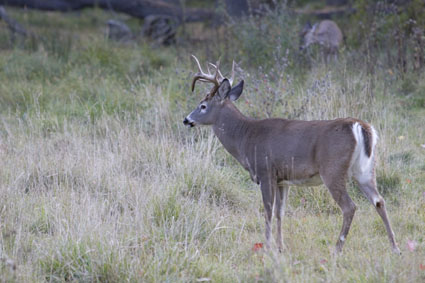 Create a prime ambush point by creating a new deer trail. Be sure to position travel direction for a broadside or quartering-away shooting angle. |
How many times have you found the perfect ambush point along a well-used deer run, but were unable to erect a treestand nearby because there simply were not any acceptable trees in the vicinity? It is a recurring problem in some circles, but Indiana outdoor writer Brand Herndon has learned how to solve that problem.
“I first locate the nearest tree for a treestand,” says Herndon. “It might be only 40 yards away, but still too far away or at the wrong angle for an ethical bow shot. My wife, Carol, and I will then move the trail so that it passes by our new treestand by fencing off the old trail with four or five little Eastern red cedar trees. We will cut the trees down (with landowner’s permission) and stake them out along the old trail blocking any forward progress. You can also use brush, old logs or dead tree limbs. Then using a stick or even our feet, we brush away the forest debris right down to make ground, in effect making a new trail that will pass by our treestand. The deer will immediately start using the new trail. It works perfectly!
“Here is another example. On one of our leases we had two deer trails the bucks were using. One was 25 yards from our stand the other was 40 yards away. We blocked off the 40-yard trail and then cleared a pathway connecting the two trails. This, too, worked like a charm. Indeed, we have learned that if the trail is not in the right place, then put it in the right place!”
Of course, moving the deer trail a few yards can also help you take advantage of a sudden change in wind currents.
“In some areas the wind can change direction 180 degrees after a storm front has passed through your hunting area,” adds Herndon, “causing bucks to adjust their travel routes and bedding areas accordingly. You can prepare in advance for these periodic weather conditions by blocking these alternate routes prior to the season opener and then adding another connecting trail so that the buck still passes by within bow range of your stand. These contingency plans can be your ace in the hole.
“Whenever you create a new deer trail, however, be sure to position it to help insure a broadside or quartering-away shooting angle. You do not want to have a racked buck walk right at your treestand, as this will only give you a head-on shot.”






